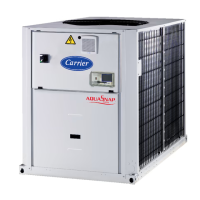51
the unit
PE
X100 10
14
QS_
Switch - MG 31102 15
Contactor LC1D12B7
Contactor LC1D25B7
QM*
TC
M6 Gnd
Gnd
QM_
Disconnect switch GV2ME10
Disconnect switch GV2ME14
Compressor strut Compressor support 30
15
M10 nut Compressor mounting 30
M16 nut 30
Oil nut Oil equalisation line 75
Taptite screw M6 7
13
Taptite screw M10 30
Metal screw Sheet metal plates
H M6 screw 10
Earth screw Compressor
We recommend, that nned coils are inspected regularly to
check the degree of fouling. This depends on the environment
where the unit is installed, and will be worse in urban and
industrial installations and near trees that shed their leaves.
For coil cleaning, two maintenance levels are used, based on
the AFNOR X60-010 standard:
• If the air heat exchangers are fouled, clean them gently
in a vertical direction, using a brush.
• Only work on air heat exchangers with the fans switched
off.
• For this type of operation switch off the HVAC unit if
service considerations allow this.
• Clean air heat exchangers guarantee optimal operation
of your HVAC unit. This cleaning is necessary when the
air heat exchangers begin to become fouled. The frequency
of cleaning depends on the season and location of the
HVAC unit (ventilated, wooded, dusty area, etc.).
WARNING: Never use pressurised water without a large
diffuser. Do not use high-pressure cleaners for Cu/Cu and
Cu/Al coils.
Concentrated and/or rotating water jets are strictly
forbidden. Never use a uid with a temperature above 45°C
to clean the air heat exchangers.
Correct and frequent cleaning (approximately every three
months) will prevent 2/3 of the corrosion problems.
Clean block tting with tap water at a pressure of 2/3 bar
and at distance of 30cm. Rub with a soft Nylon, PolyPro
®
or Tynex
®
brush
Protect the control box during cleaning operations.
Check that:
• the insulating foam is intact and securely in place.
• the cooler heaters are operating, secure and correctly
positioned.
• the water-side connections are clean and show no sign
of leakage.

